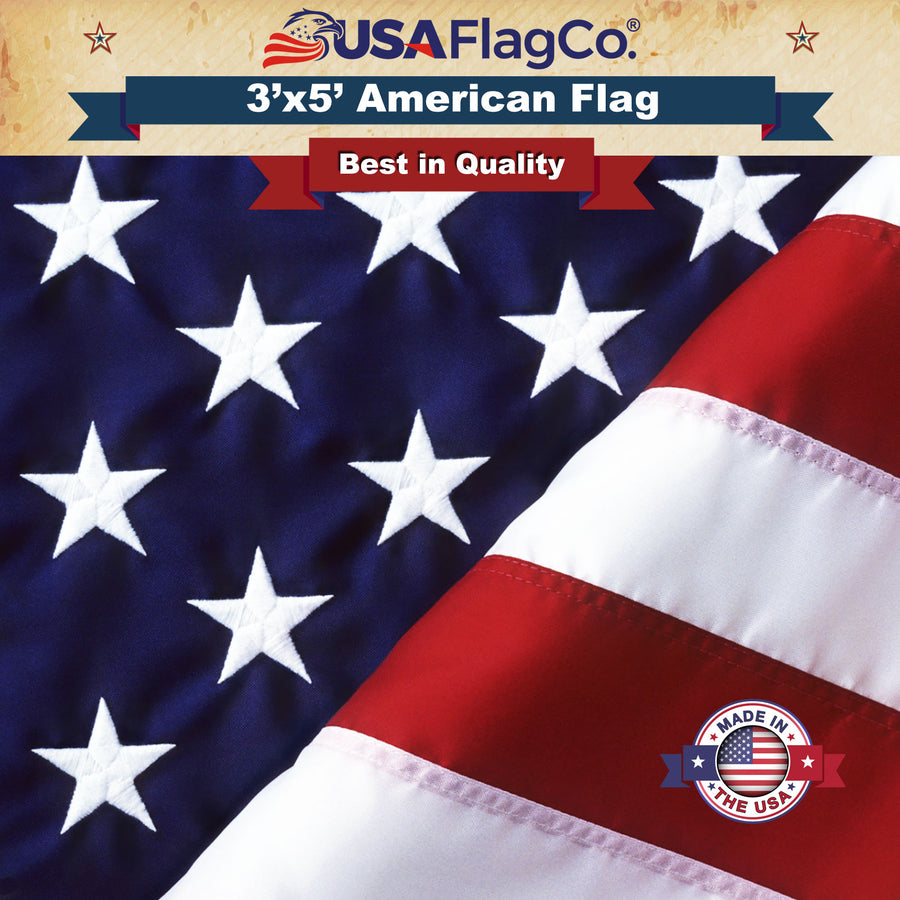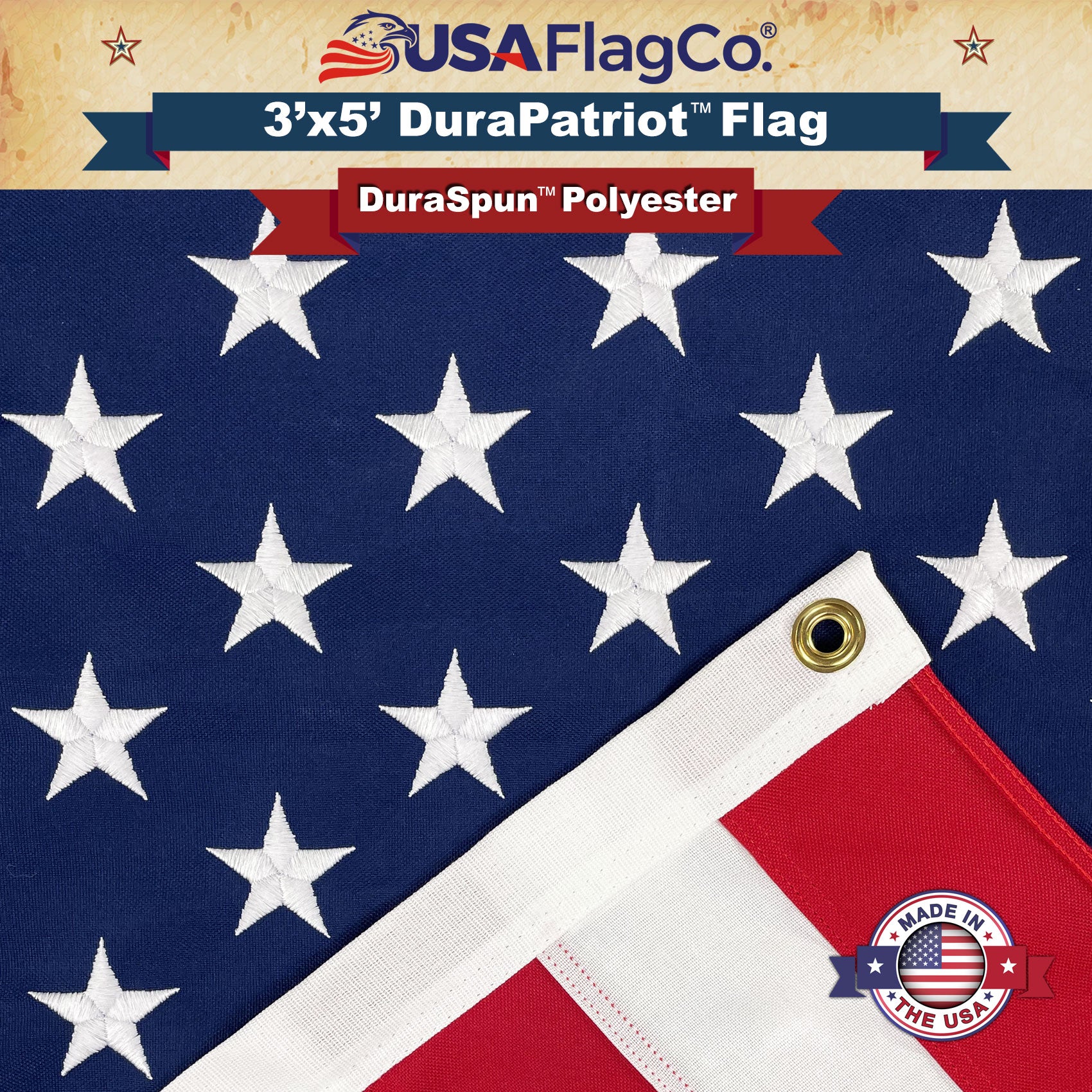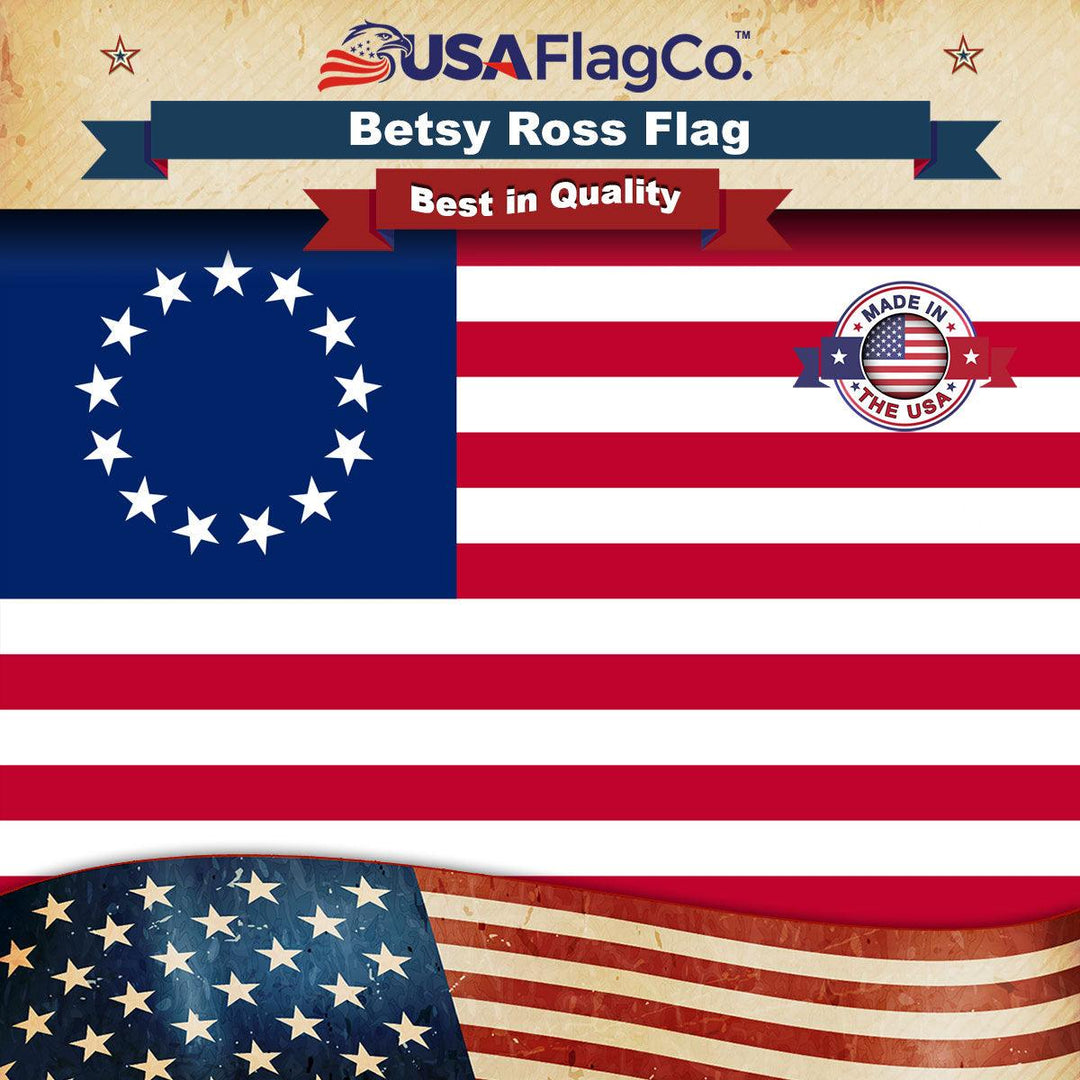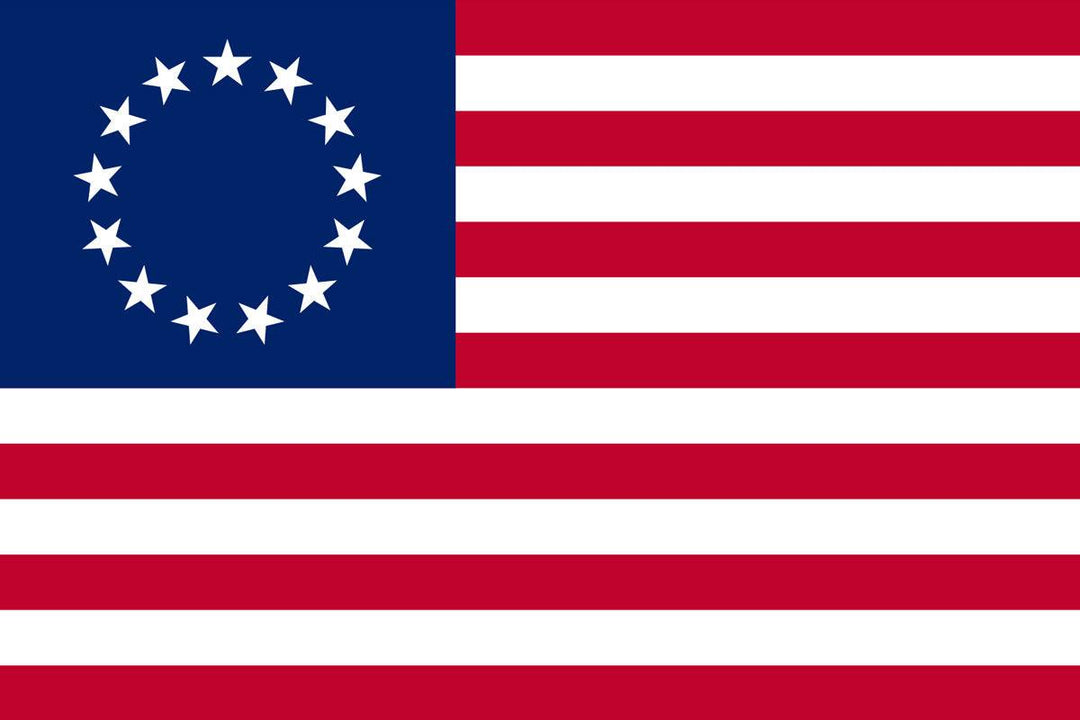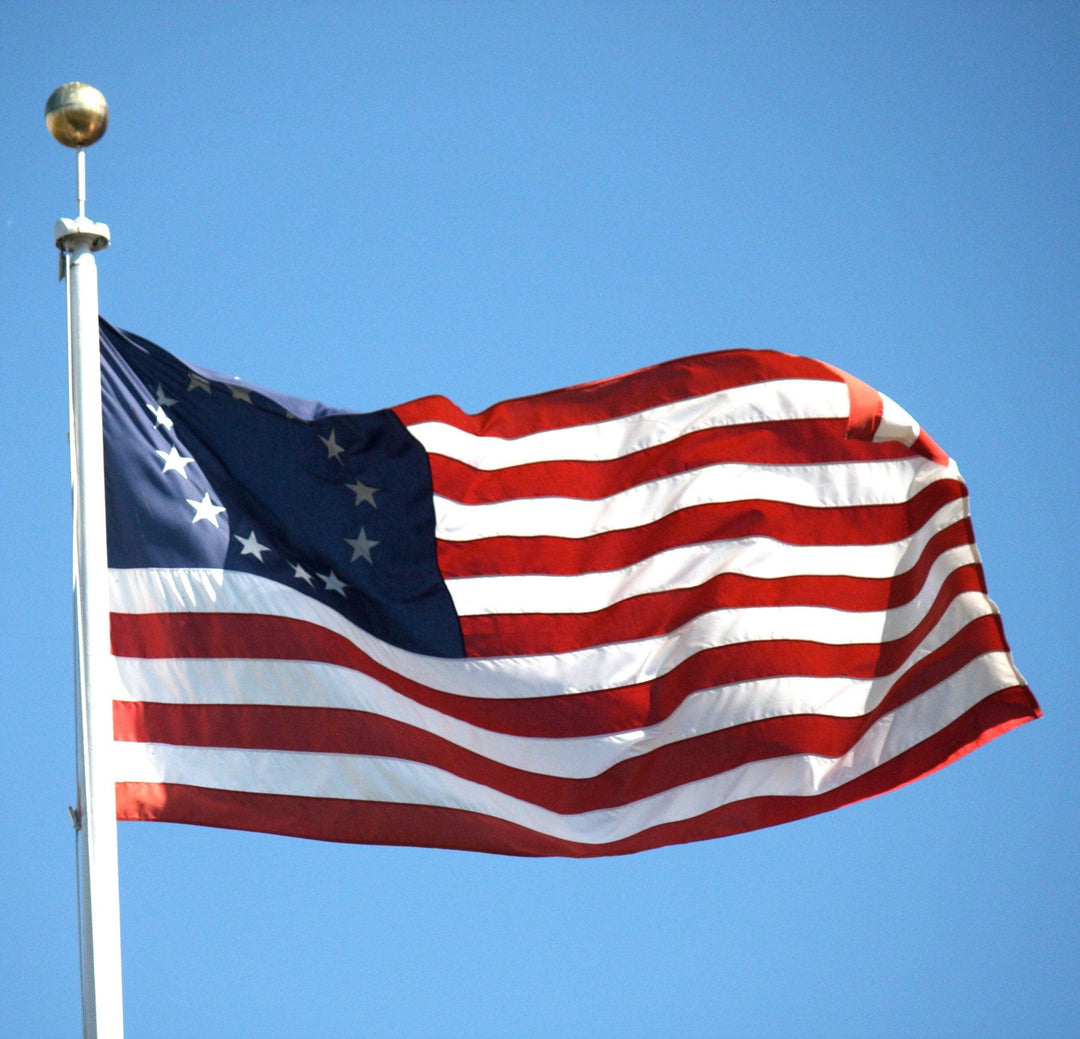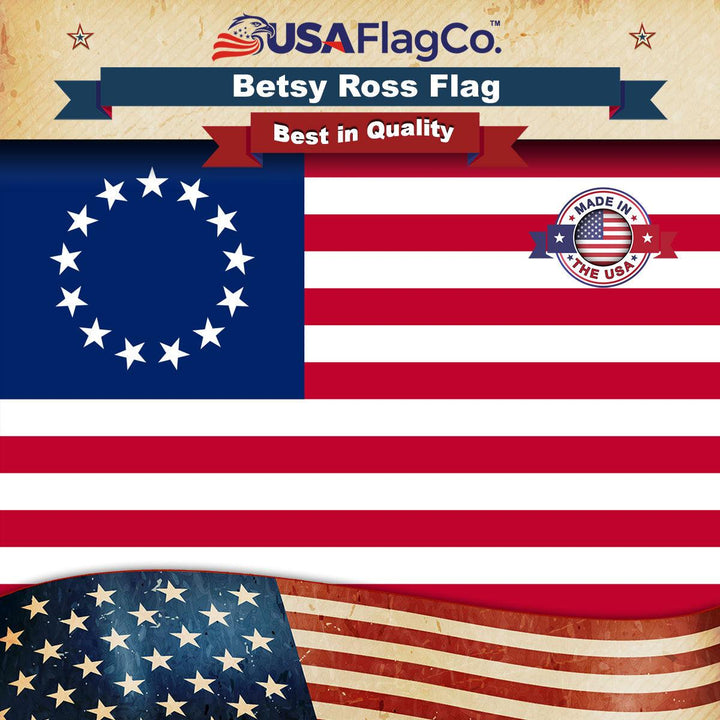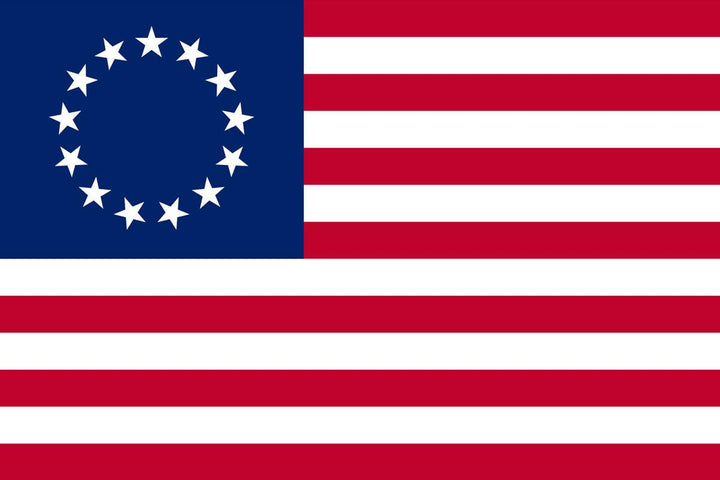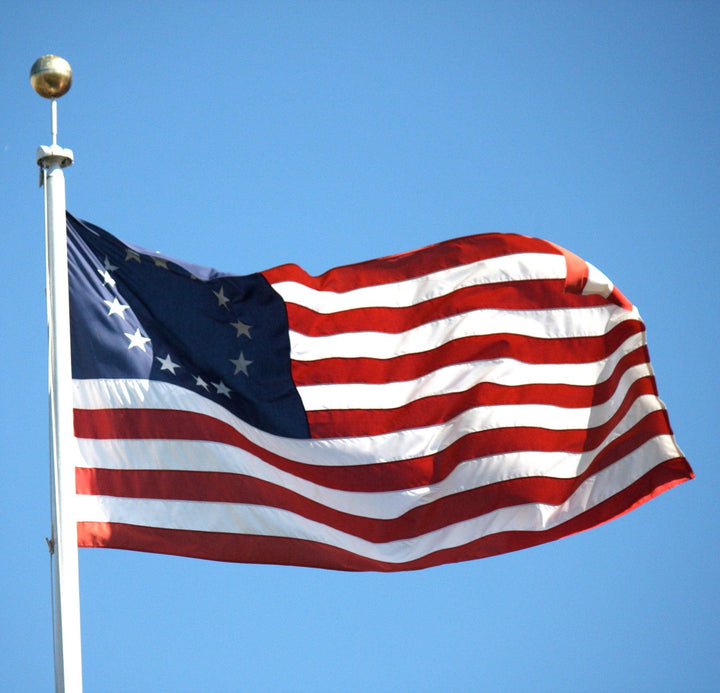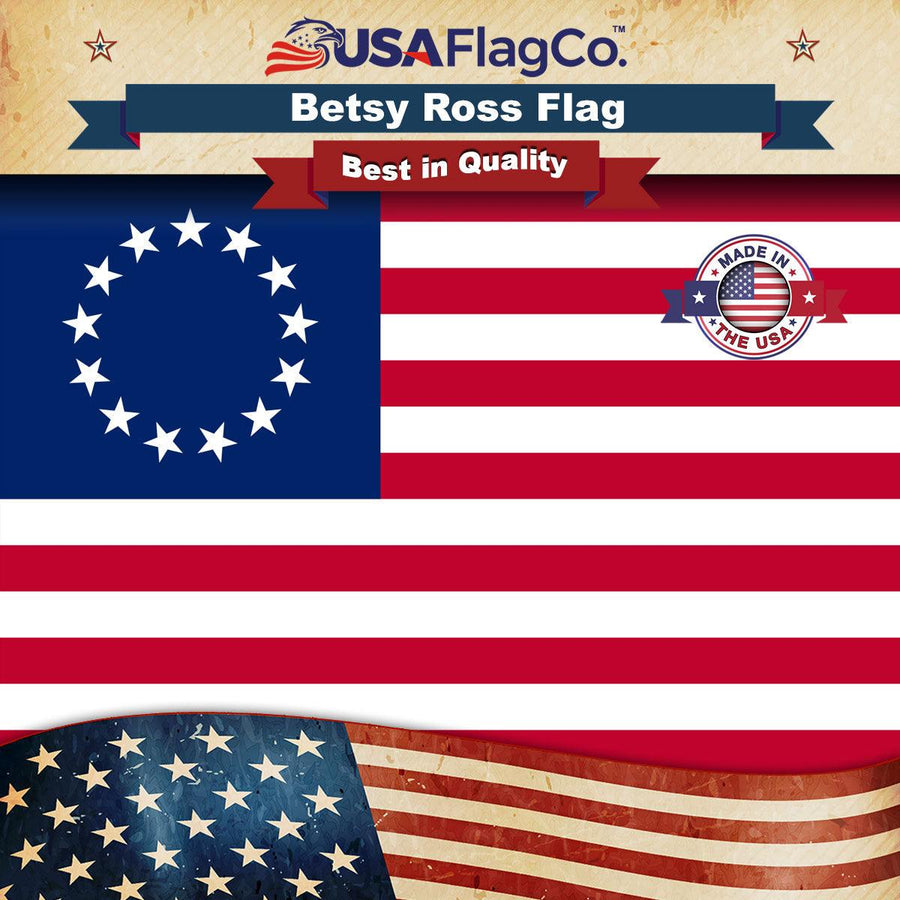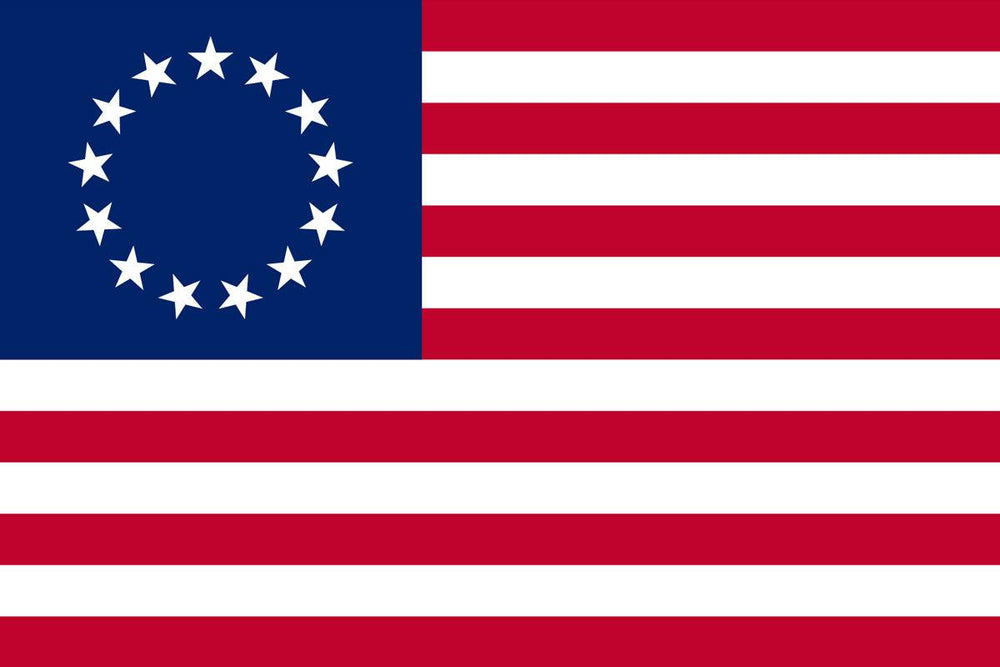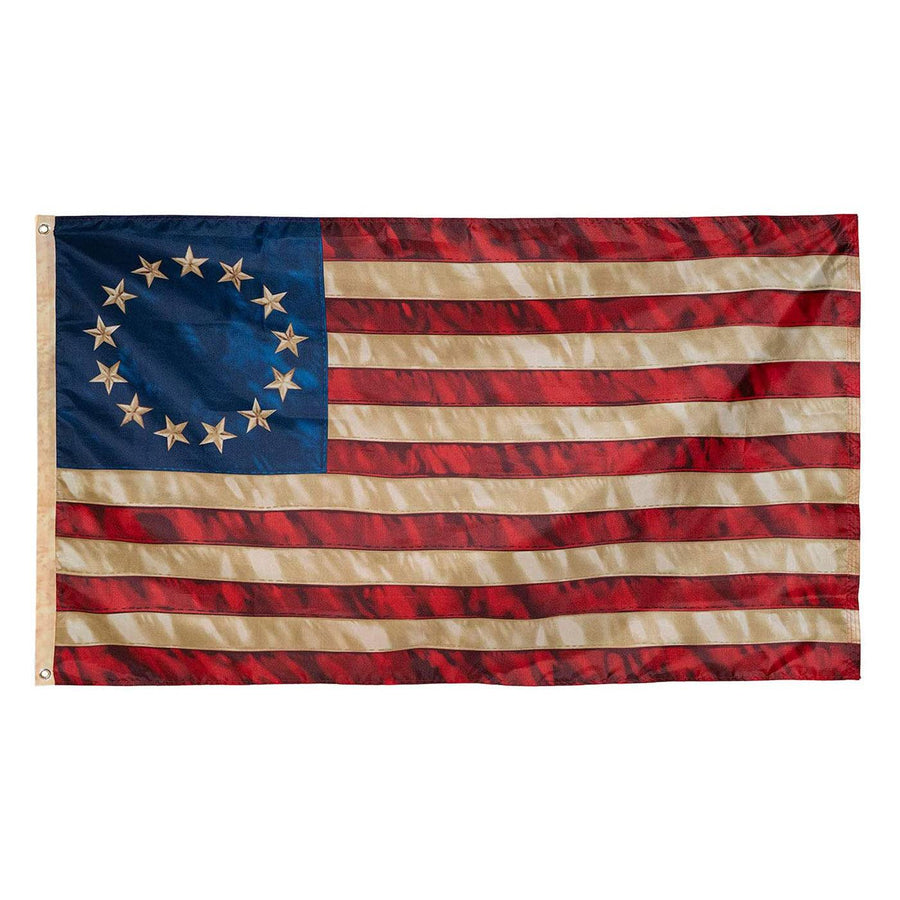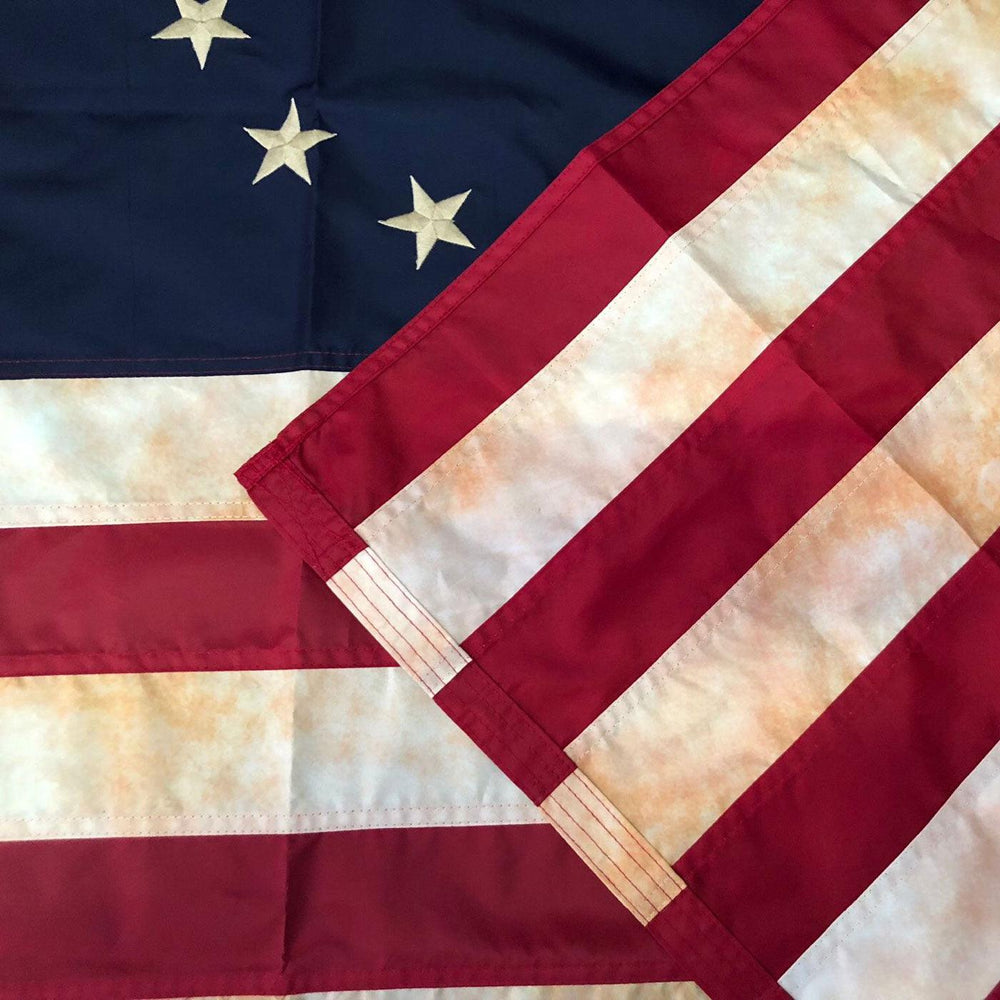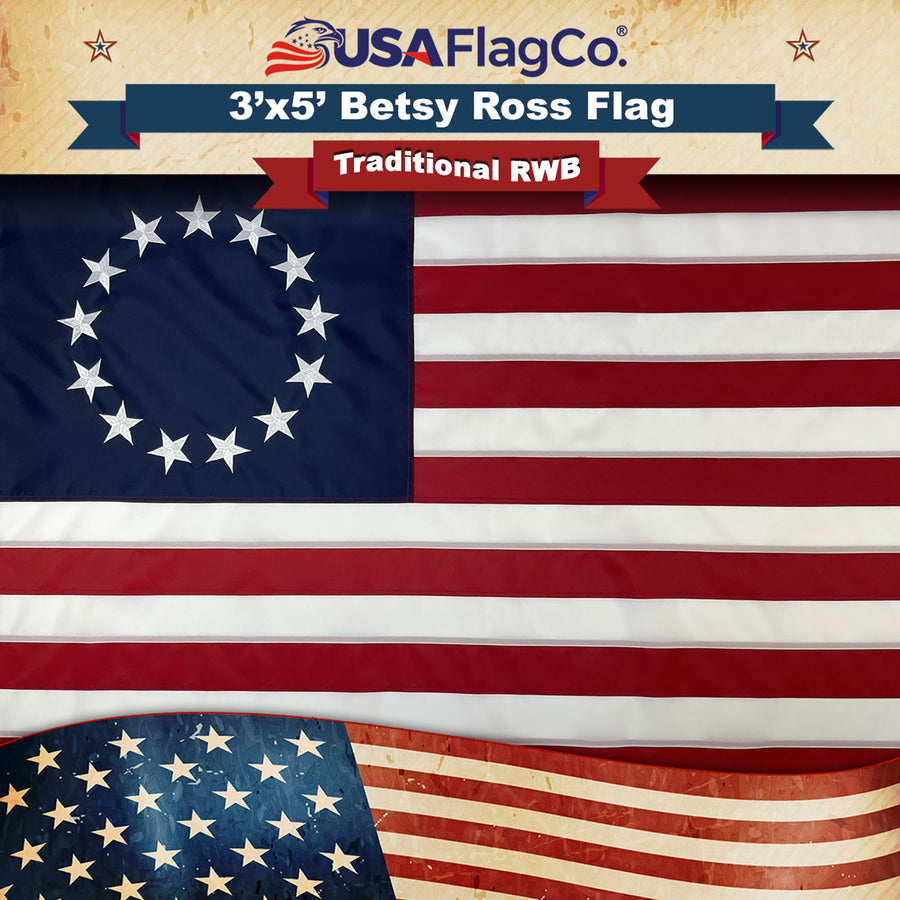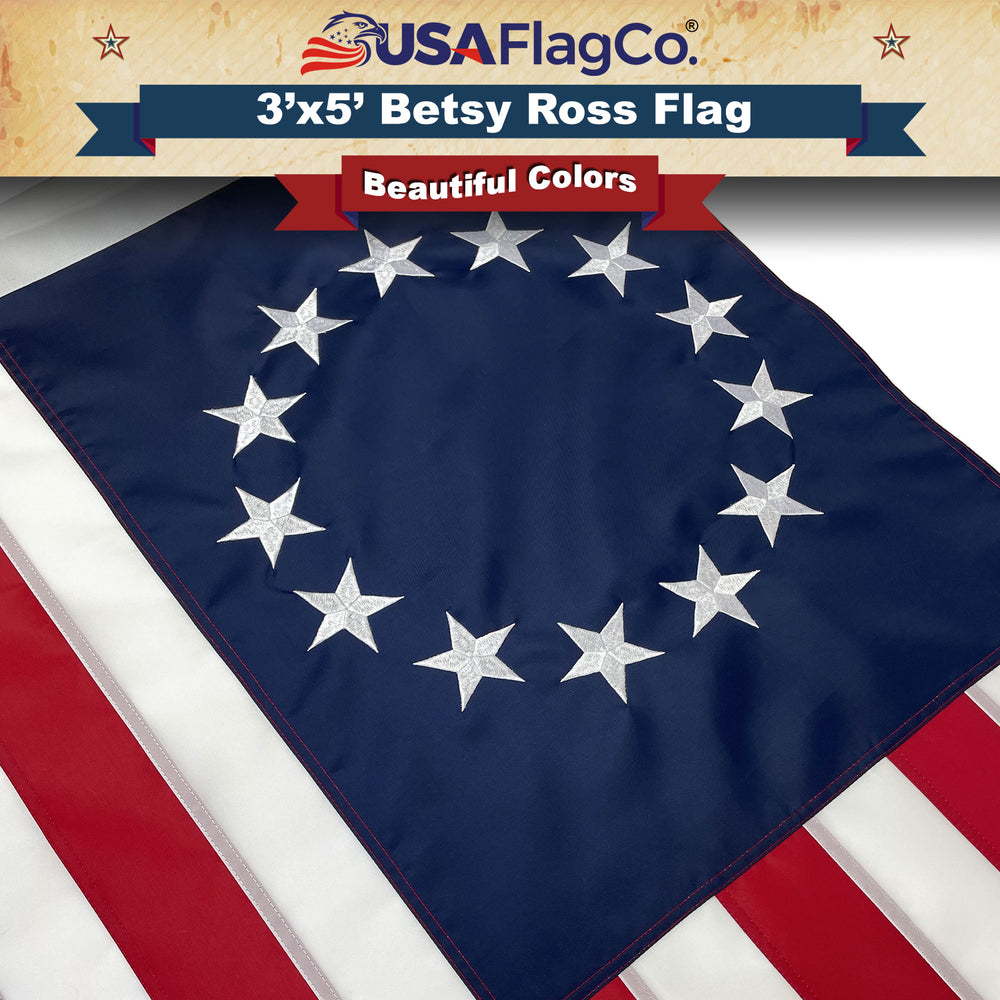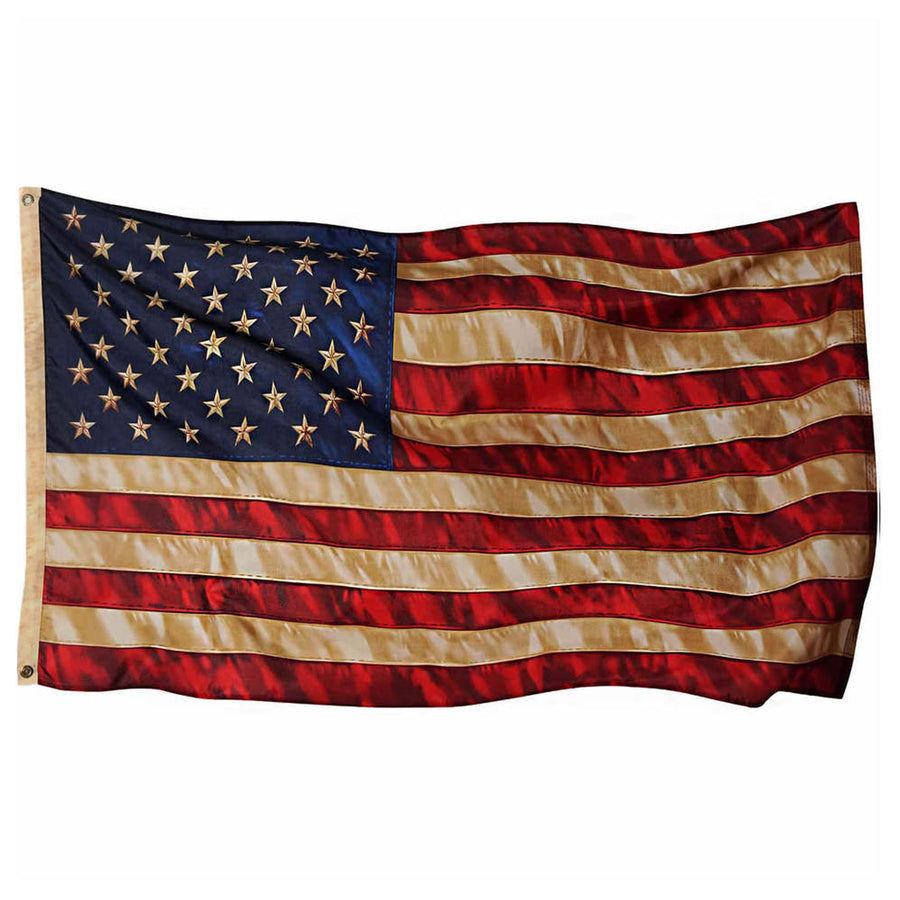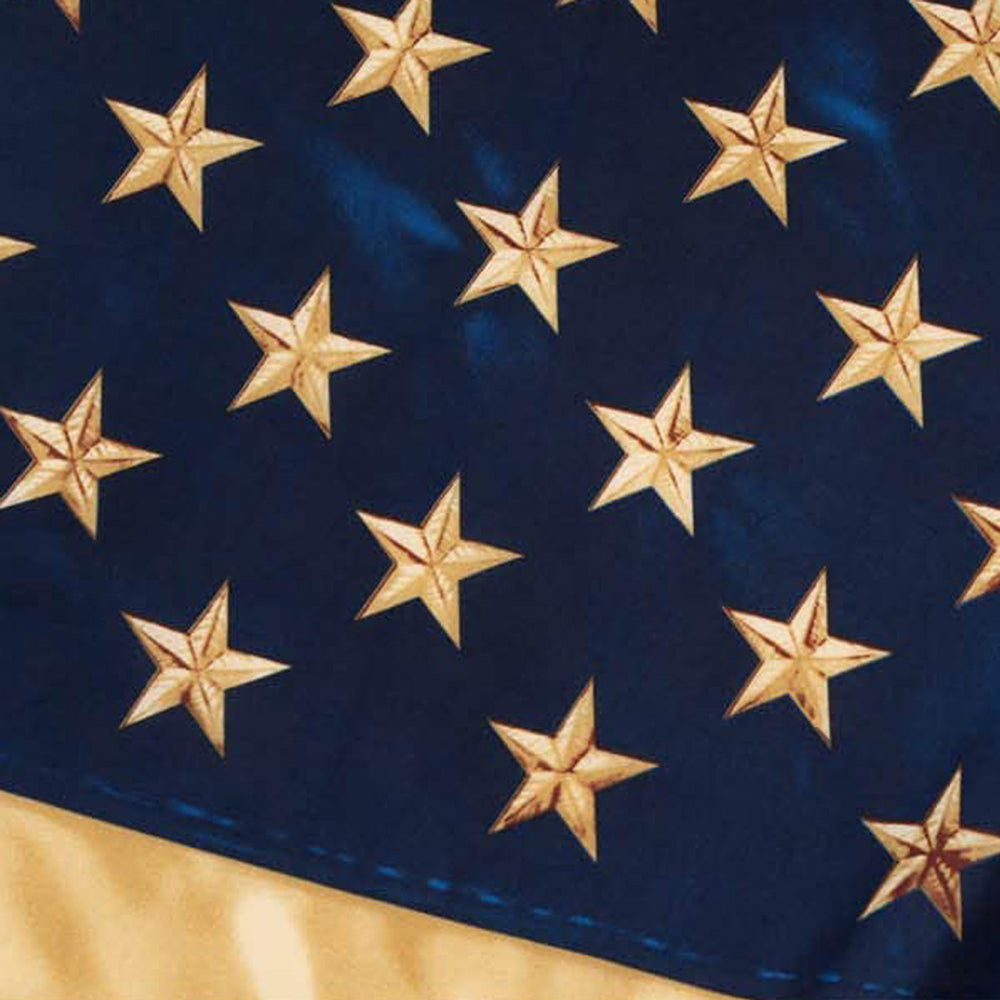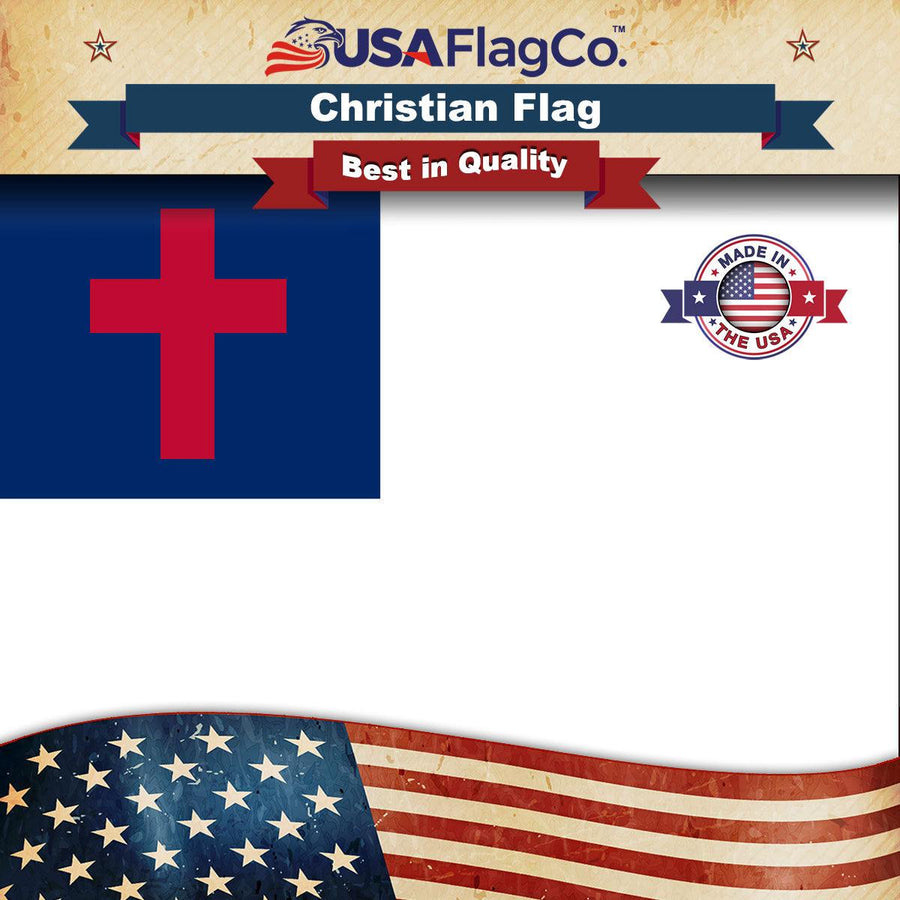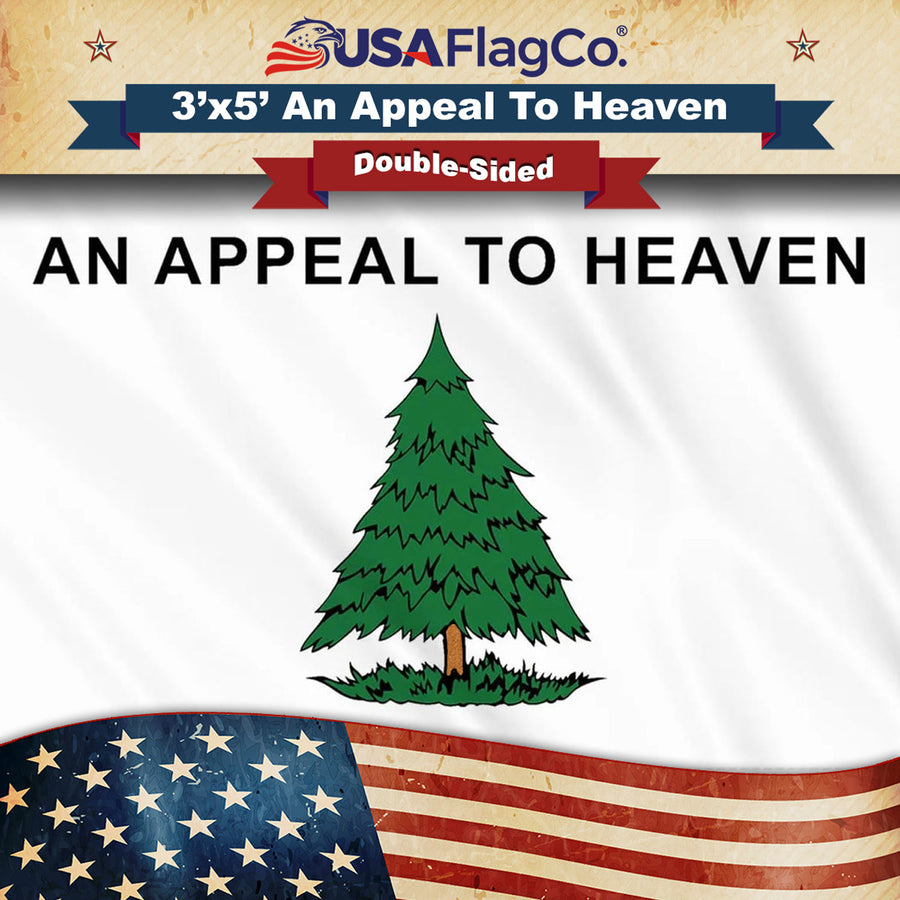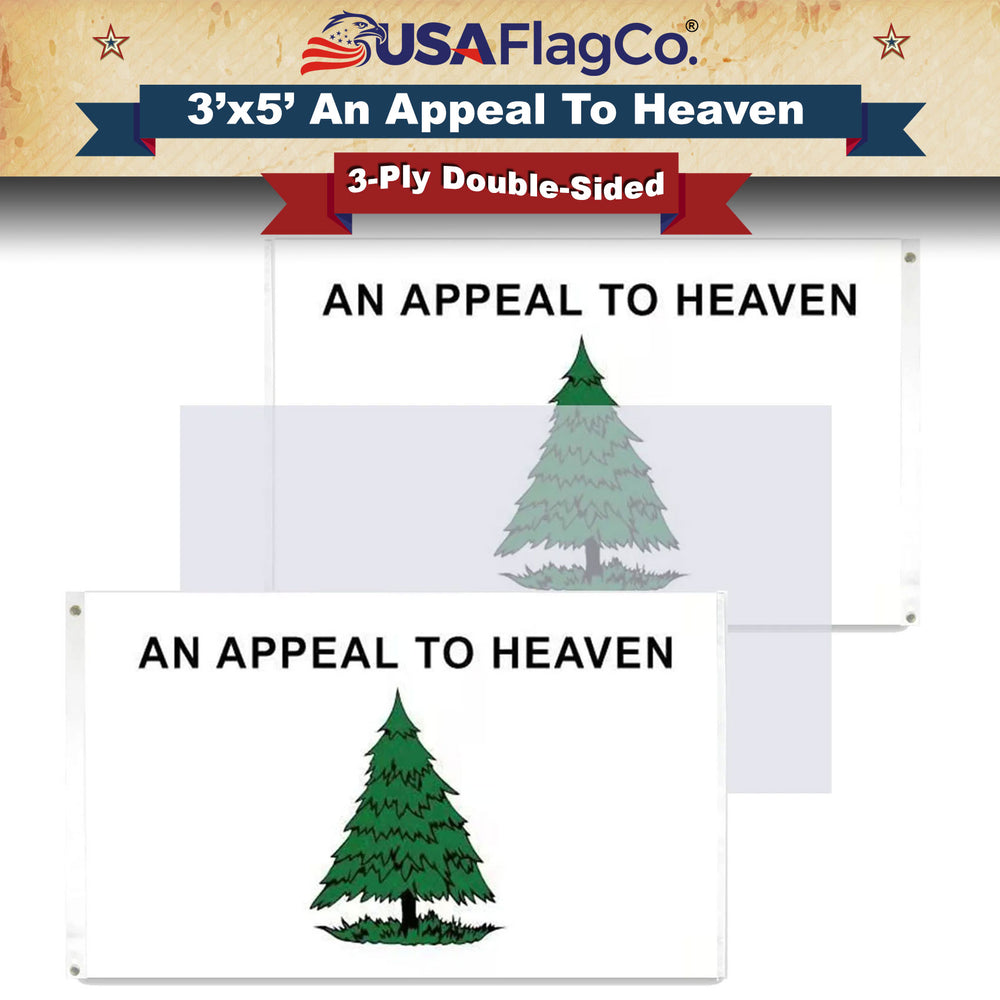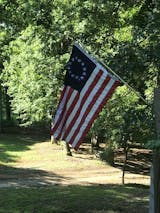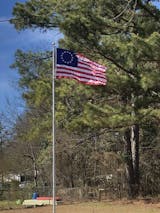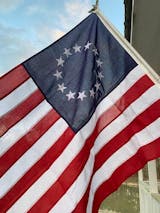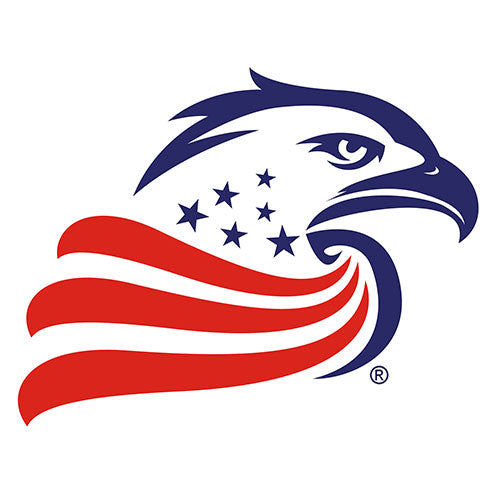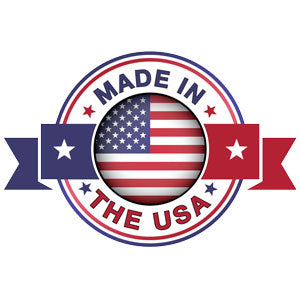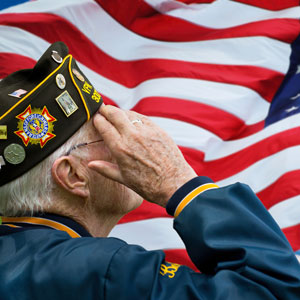Betsy Ross Flag or Betsy Ross Banner
The Betsy Ross flag or banner by USA Flag Co. is manufactured using Embroidered Stars & Sewn Stripes for both the flag and banner styles. All USA Flag Co. flags are finished with polyester heading and brass grommets.
DID BETSY ROSS DESIGN THE FLAG OF THE UNITED STATES OF AMERICA?
By Franklin Hanford.
A paper read before the Scottsville Literary Society, January 22, 1917.
On Saturday, the fourteenth of June, 1777, the Continental Congress, then in session in Philadelphia, adopted a resolution that reads as follows:
"Resolved, that the flag of the thirteen United States is thirteen stripes, alternate red and white; that the Union be thirteen stars, white in a blue field, representing a new constellation."
"The Journal of Congress is silent as to the name of the member or committee that introduced this resolution and neither is there any record of the discussions that may have preceded the adoption of our national emblem." "It is a matter of great regret that no record of the circumstances attending the birth of the Stars and Stripes has ever been found," for we should like to know who designed our present flag, and also, though a matter of less interest, who made, that is manufactured, the first one.
Some years ago I happened to see upon the wall at Mrs. Emma H. Miller's house in Scottsville, a very attractive picture in colors. This picture represented General Washington seated on the left and Robert Morris and the Hon. George Ross standing near him, while, seated on the right, was Betsy Ross with a completed flag of thirteen stripes, and thirteen stars in a blue field, in her lap. "C. H. Weisberger, Copyright 1903," was inscribed near the bottom of the picture. Underneath it was this legend; " Birth of our nation's flag. The first American flag accepted by Congress and adopted by the resolution of Congress on June 14, 1777, as the national standard, was made by Betsy Ross, in 1776 at 239 Arch Street, Philadelphia, in the room represented in this picture. The Committee, Robert Morris, and Hon. George Ross, accompanied by General George Washington, called upon this celebrated woman and together with her suggestions, produced our beautiful emblem of liberty."
The legend under this picture led me to make some inquiries about Betsy Ross. Who was she? And did she assist in designing and did she make the first flag or ensign of the United States of America? If not Betsy Ross, who did design and make it? Endeavoring to answer these questions, I have consulted some thirteen works relating wholly or in part to the flag of the United States. A list of them is appended to this paper.
Betsy or Elizabeth Griscom was the fifth daughter of Samuel and Rebecca (James) Griscom and was born on January 1, 1752. She was married when quite young to John Ross, son of the Reverend Aeneas Ross, an Episcopal clergyman of Newcastle, Delaware, whose brother, the Hon. George Ross became one of the signers of the Declaration of Independence. George Ross was interested in the furnishing of cannon-balls, with perhaps other military stores for the Colonial defense, and it was while on guard at night over these, with other young men, that the nephew, John Ross, Betsy's first husband, received an injury from the effects of which he died in January 1776.
It was during her widowhood that Betsy Ross is said to have made the first Stars and Stripes. For a second husband, she married a sea captain, John or Joseph Ashburne, who died in Mill Prison, England, in 1782. The following year, she married Ashburne's prison mate, John Claypoole, who died in 1817.
Betsy Ross died in her daughter's home in Philadelphia on January 30, 1836, aged eighty-four. She was buried in the Cemetery of the Society of Free Quakers on South Fifth Street, from which place her remains were transferred in 1857 to Mount Moriah Cemetery. Four of her daughters grew up and married. Betsy Ross' first husband was an upholsterer. She continued his business and for fifty years was an expert needlewoman, lace-maker, and flag-maker. After her death, Mrs. Clarissa Wilson, one of her daughters, succeeded in the business and continued to make flags for the arsenals and navy yards and for the mercantile marine for many years. But being conscientious on the subject of war, Mrs. Wilson gave up the Government business but continued to make flags for the merchant marine until 1857.
The earliest "History of the National Flag," of which I have the knowledge, was written by Captain Schuyler Hamilton, U.S. Army, and published in Philadelphia in 1853, sixty-four years ago. Captain Hamilton makes no mention of Betsy Ross and does not give to anyone person or group of persons the honor of designing our flag.
The next "History of Our Flag" was written by Ferdinand L. Sarmiento and published in 1864, during the Civil War, in Philadelphia. Sarmiento, like Captain Hamilton, does not mention Betsy Ross and does not credit the origin of our flag to any one person or to any committee, or group of persons, but considers honor due to many individuals who assisted, more or less, in the development of our flag.
So far as I can learn, no mention of Mrs. Ross occurs in any history of our country or in any of the many biographies of Washington, prior to 1870, ninety-three years after the flag was adopted. In that year, however, "Mr. Wm. J. Canby of Philadelphia, read before the Historical Society of Pennsylvania, a paper on the history of the American flag, in which he stated that his maternal grandmother, Mrs. John Ross, was the first maker and partial designer of the Stars and Stripes." Mr. Canby said that Mrs. Ross received a call in June 1776, from General Washington, Col. George Ross, and Robert Morris, who told her they were a Committee of Congress and wanted her to make a flag from a rough drawing they had, which draws, upon her suggestion, was redrawn by Washington in pencil. This was prior to the Declaration of Independence. Mr. Canby claimed that he had heard his grandmother tell the story when he was a boy eleven years old and that three of Mrs. Ross' daughters then living in 1870 and a niece, aged ninety-five, confirmed his statements.
In the picture I have referred to, Mrs. Ross is represented as having a completed Stars and Stripes in her lap, although, at the time of the visit of the Committee to her, according to Mr. Canby's statement, the flag had not even been designed or manufactured.
The best and most complete "History of the Flag of the U. S. of America" was written by Rear Admiral George H. Preble, U.S. Navy. The first edition was published in 1872 and the second, revised, edition, in 1880. Rear-Admiral Preble gives Mr. Canby's story about Mrs. Ross in full, and he considers it probable that Mrs. Ross did manufacture or have manufactured at different times flags of the United States of various designs. His conclusion, however, is that "it will probably never be known who designed our union of stars, the records of Congress being silent on the subject and there being no mention or suggestion of it in any of the voluminous correspondence or diaries of the time, public or private, which have ever been published."
In 1878, a ridiculous pamphlet was published, entitled "The History of the First United States Flag and the Patriotism of Betsy Ross, the Immortal Heroine that Originated the First Flag of the Union. Dedicated to the Ladies of the United States by Col. J. Franklin Reigart." This was published in Harrisburg, Pennsylvania.
In Reigart's book, the claim is made that Mrs. Ross "originated" our flag. Mr. Canby, Mrs. Ross' grandson, had claimed only that she manufactured it and that she suggested some changes in the sketch shown to her by the committee. In Reigart's book, there is a pretended portrait of Betsy Ross making the first flag. This was really the portrait of a Quaker lady of Lancaster and was taken from a photograph. Mr. Canby repudiated Reigart's book and said he did not correctly present his grandmother or her claim.
In 1876 Mr. J. C. Julius Langbein wrote a small history of our flag and he accepts Mr. Canby's account of Mrs. Ross making the first flag and suggested some changes in the original design.
Learning that a book entitled "Betsy Ross" had been published in 1901, I procured a copy thinking it biographical or historical but it proved to be a romance, pure and simple, woven about Mrs. Ross who is represented as the heroine of her day and the principal designer of the flag.
Since 1891, several small works on the flag have been published, written by members of the Daughters of the American Revolution, and dedicated to that organization. In those works great honor is given to Mrs. Ross, indeed, the members of the D.A.R. as a whole, seem to have accepted Mr. Canby's story as beyond dispute.
In 1908, Mr. John H. Fow published in Philadelphia a book of fifty-four pages entitled "The True Story of the American Flag." Mr. Fow devotes considerable space to the claims made for Mrs. Ross and considers them without any documentary or record proof. He says, "If Mrs. Ross made a flag in an Arch Street house as claimed, it was made after a design that had been conceived and born somewhere else, and her contribution was no more than the labor that is given by any girl or woman in a flag manufactory. Even according to the paper which was read (by Mr. Canby) before the (Historical) Society in 1870, it is admitted that a design made by someone else was taken to her but that she made some changes to it. Now," says Mr. Fow, "that is all there is in the Betsy Ross claim. Yet the growing youths of the nation are being misled and taught a historical untruth." Mr. Fow also says that the Canby claim "is practically charging Washington and the rest of the Committee with seeking to establish and set up in June 1776, a national ensign before we had declared ourselves a free people on July 4, of the same year, and without any delegated authority to do so, the record of Congress being silent on the subject."
I will not quote further from Mr. Fow's book, as to do so would unduly lengthen this paper, but the book itself can be found in the Scottsville Free Library.
I have lately found in the "Manual of Patriotism for Use in the Public Schools of the State of New York, Edition of 1904, Compiled, Arranged and Edited under the direction of Charles R. Skinner, State Superintendent of Public Instruction "the following in relation to the origin of our flag, "A Committee of Congress accompanied by Washington sought out the home and services of Mrs. Elizabeth Ross of Philadelphia - better known as Betsy Ross - to aid them in the flag-making. Her skillful hands and willing heart soon worked out a plan and gave to this country that red, white, and blue banner which is the admiration of all nations and the unfailing joy of every true American." All of which is a very fine example of what may be called "patriotic gush."
Here you observe that Mr. Skinner gives Mrs. Ross all the credit for working out and giving us the flag. As it seemed to me that that sort of history and patriotism is all wrong and as there is, I believe, no warrant for that statement, I wrote on September 16, 1916, to the State Superintendent of Public Instruction at Albany, and asked to be furnished with the authority upon which that statement was based. A reply came very promptly signed "Wilmer L. Hall, Sub-librarian in history," to whom my letter had been referred for the reply. Mr. Hall says, "The statement you quote may be based upon one or more of the several histories of the American Flag. See for example; Peleg D. Harrison, The Stars and Stripes, 5th edition, 1914, and C.W. Stewart, The Stars and Stripes, 1915. These accounts do not assert that Betsy Ross originated the American flag but allow her the credit for making the first one. It is said that Congress appointed a Committee consisting of General Washington, Col. George Ross, and Robert Morris, who called upon Mrs. Ross and submitted to her a rough drawing of the flag. As the American flag is a growth rather than a creation, its exact origin is not determined; nor is the date of the manufacture of the first one by Mrs. Ross and the date of its first use matters of exact knowledge."
Upon examining the two works referred to by Mr. Hall, I find that Mr. Harrison says that" the credit of making the first flag combining the Stars and Stripes is generally given to Mrs. Betsy Ross, and the story of its making is somewhat familiar to all." Then Mr. Harrison goes on to give Mr. Canby's account of what his grandmother told him.
Mr. Stewart in his book says, "Tradition tells us that Mrs. Elizabeth Ross, known as Betsy Ross, of Philadelphia, constructed the first Stars and Stripes flag. Though we have no official record of the making of this first United States flag, the accounts given by Betsy Ross' relatives are generally accepted."
I will here call attention to the use by Mr. Hall, Mr. Harrison, Mr. Stewart, and other writers of such expressions as "It is said," "Tradition tells us," "It is believed," "Credit is generally given," and so forth and so forth. These expressions are to history what the expression "they say" in common gossip or talk is to the truth, and are worth just as much. The fact that a thing is generally believed does not make it true.
Sometime after the receipt of the foregoing letter from Mr. Hall, I wrote him suggesting that the account is given on page 5 of the "Manual of Patriotism" previously quoted, be corrected to agree with the facts.
It will be noted from the above correspondence that the State Department of Public Instruction does not now assert, as it did in 1904, that Betsy Ross originated the design of the flag for the United States.
What became of the flag that Betsy Ross is said to have made in June 1776? In all the engagements that took place between the American and British troops from June 1776 to August 1777, there is no record in existence, public or private, that the flag claimed to have been designed by Mrs. Ross in June 1776, was carried.
The first time that the Stars and Stripes were carried by American troops was at the battle of the Brandywine, in September 1777.
The Annals of the American Congress do not say that any Committee was appointed to design the flag. Washington made no note of a visit to Mrs. Ross' house, although he was a voluminous letter-writer and kept most detailed diaries, and his writings do not contain a word that suggests when the first United States flag was made or designed. Neither do any of the distinguished historians of the Revolutionary period give us light on this question. Newspapers of Philadelphia, issued at that time, did not chronicle any portion of the story as told by Mr. Canby ninety-three years after the flag was adopted by Congress. Mrs. Ross did make State colors for vessels and batteries prior to June 14, 1777, but it was not until after the Stars and Stripes were ordained that she became a Government flagmaker.
The Betsy Ross legend has grown up since 1870 entirely from her grandson's statement as to what he and other descendants had heard her say. This legend is now generally believed and taught in our schools as history.
The people of our country are very apt at setting up idols of one kind or another and at manufacturing heroes and heroines. That Betsy Ross was a good woman, and an industrious and competent seamstress is entirely probable. That she was brave, we may believe, - she married three husbands!! At all events, we have now Betsy Ross Chapters, Betsy Ross Auxiliaries, and Betsy Ross this, that, and the other. And her former home at 239 Arch Street in Philadelphia has been bought and is preserved by the "American Flag House and Betsy Ross Memorial Association." And a large sign across the front reads, "Birthplace of Old Glory."
Now with your permission, I will give my own conclusions on the subject. The evidence that General Washington, Robert Morris, and Colonel George Ross called upon Mrs. Ross in June 1776, and asked her to make a flag from a sketch that they showed her, that Mrs. Ross suggested alterations in the design, which the Committee accepted, and that she made a flag from the modified design which flag was a year later adopted by Congress as our national ensign, is entirely hearsay evidence. It is based solely on statements by Betsy Ross's descendants as to what they heard her say. This evidence, I think, would not be accepted in a court of law, and therefore it is not proved that Mrs. Ross either designed or manufactured our first flag.
I read a portion of this paper on June 14, 1912, before the Caledonia chapter of the D.A.R., and asked them this question, Would you admit to membership in your society a person whose sole claim to membership was based on what she had heard her grandmother say? The unanimous reply was that they could not admit such a claimant.
Possibly there may be some better evidence than I have been able to find to substantiate the claims made for Betsy Ross; but until such evidence is produced, then the people of our country should be taught the facts of the case and not a legend as a fact.
The answer, then, to the question propounded at the beginning of this paper is, that Betsy Ross did not design the flag of the United States of America.
NOT ALL BETSY ROSS FLAGS ARE THE SAME!
HERE'S WHY...
Extra care is taken in making these flags. Flag designs are researched to ensure that they are authentic and current. We use sturdy fabrics, allowing the flags to be flown outdoors, indoors, or carried in parades.
Choose Heavy Duty Nylon (digitally dyed) or 2-ply Polyester Material (screen dyed) to meet the most demanding commercial and residential uses.
- All outdoor flags are finished with heavy-duty thread, polyester heading, brass grommets, and four-needle fly hem
- State flags constructed to precise specifications
- Flies in the slightest breeze
- Proudly Made In The USA
- Beautiful Presentation - This Betsy Ross Flag makes an excellent gift for friends, and parents, or to PROUDLY display on your HOME or OFFICE.
HEAVY-DUTY NYLON OUTDOOR HISTORICAL FLAGS WITH SOLAR SHIELD
Our most popular and versatile outdoor Betsy Ross flag, USA Flag Co. flags offer the optimum combination of elegance and durability for every purpose. The 100% nylon material provides a rich, lustrous appearance. Our flags have superb wearing strength due to the material’s superior strength-to-weight ratio and will fly in the slightest breeze. Historical flags are finished with strong, polyester canvas headings and spurred brass grommets, and four-needle fly hem. The result is a flag that will be flown with pride year after year.
SOLAR SHIELD
- Rich, Vivid Colors
- Durable
- Fire-Resistant
- Mothproof
- Mildew Resistant
- Sheds Water
- Lightweight for Flyability
HEAVY-DUTY POLYESTER OUTDOOR HISTORICAL FLAGS
The strongest, longest-lasting material, developed for maximum durability in strong wind conditions and intense sun. USA Flag Co. polyester flags are made of tough 2-ply 100% spun polyester. They stand up to unpredictable weather conditions. Each Betsy Ross flag is finished with a tough polyester canvas heading and spurred brass grommets and four needle-fly hem.
- Heavy 2-ply Yarns For Extra Strength and Durability
- Withstands Wind, Sun, Dirt, and Moisture
- Outlasts Nylon and Other Acrylic Flags
- Excellent for Industrial / Institutional Use
Add this Betsy Ross Flag to your cart for Immediate Delivery Now.
Reference:
Did Betsy Ross design the flag of the United States of America?
Main Author: Hanford, Franklin, 1844- [from old catalog]
Language(s): English
Published: Scottsville, N.Y., I. Van Hooser, printer, 1917.
30-DAY MONEY BACK GUARANTEE
USA Flag Co. wants you to be completely and perfectly satisfied, and that is why we offer a 30-day money back guarantee from the date you ordered your product(s). Now don't get me wrong, we'd love to know why you didn't like it, but only if you are willing to tell us. Otherwise, it's 100% satisfaction guaranteed return. No questions asked.
We take all the risk out of ordering by offering an unmatched satisfaction guarantee. We'll always do our best to take care of you.
100% SATISFACTION GUARANTEE!
Free standard shipping on orders over $60. Full shipping policy
This product is eligible for returns. Full returns policy
Frequently Asked Questions
This is the most common question asked in the industry and the most difficult to answer. No two flags will wear the same due to weather conditions and how often the flag is flown. Our flags offer the best stitching and highest quality materials to get your flag off to a great start.
Do not hang a flag where the wind will whip it against rough surface, such as tree branches, wires or cables or the outside of your home or building. Inspect your flags regularly for signs of wear. Repair any minor rips or tears right away this can be mended easily with a sewing machine or sewing kit. Keep the surface of the pole free of dirt, rust or corrosion that could damage or stain your flag.
We recommend that you hand-wash your flag with mild soap, rinse thoroughly and air dry. You can also use a dry cleaning service.
Exposing your flag to rain, wind, snow or high winds will shorten the life of your flag considerably. If you leave your flag exposed to the elements, it will greatly reduce the life of your flag.
Yes, as long as your pole is large enough to support the weight of the flags. The USA Flag must always fly at the top. The flag underneath should be at least one foot lower and be one size smaller than the USA Flag. Flags of other countries are not to be flown beneath the USA Flag.
If your flag is significantly faded, torn or tattered it is time to retire your flag. Your flag should be retired privately in a dignified manner. In addition, many local community organizations have flag disposal centers that will dispose of your flag for you.


